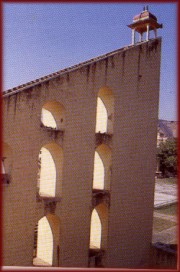|
 |
|
Literally
means the king of all the instruments. It is not only the biggest of all the yantras but
also in accuracy and excellence of its construction. We are aware of the fact that, jaipur
time is observed by solar system. the smarat serves the purpose to find out local time
correct up to 2 seconds. The gnomon is ninety feet high and has niches in to wall so that
storms do not affect the instrument. The gnomon is right angled wall and the hypotenuse
has steps to climb up. The hypotenuse has also a scale to find out the altitude of the
sun. The hypotenuse points towards the pole On either side of the pole is masonary
quadrant. the centres of which lie on the edge of gnomon. The edge of quadrants are
graduated in hours, minutes and seconds. In this scale one minute has been divided to the
extent of 30 parts, this way it is accurate upto 2 seconds. Steps are provided near the quadrants so that the observer
may climb up and find the readings of the instrument precisely. The smarat may be
described as gigantic Sunadial. |
Samrat
Yantra |
|
|
| At Six O' clock in
the morning the shadow of gnomon falls on the top of western quadrant some 50 feet away
and as the Sun-rises higher, the sun descends along the arc of quadrant until at
apparent noon. It disappears the sun being then due south and place of the gnomon. But
only for an instant immediately noon is the past, the shadow commences to climb the
eastern quadrant until six O'clock in the eavning, the whole quadrant read from the
position of the shadow on the quadrant by adding the differene of equator time, indian
standard time could be observed. At
night, the time is observed with the help of a thread. One end of the thread is put in
contact with the edge of the gnomon and the other with the edge of one the quadrants, the
reading of the quadrant then give the time that had or would elapse since or before the
star had been or would be on the meridian. |
|